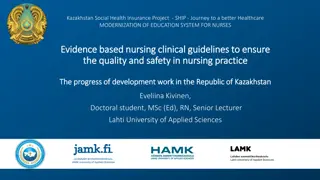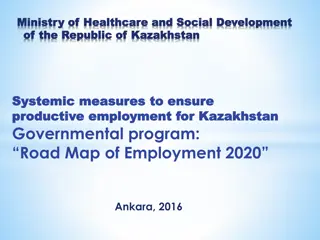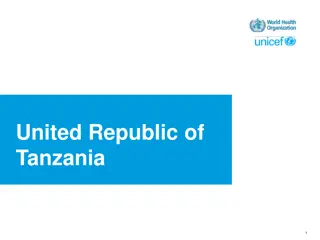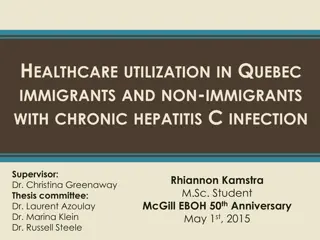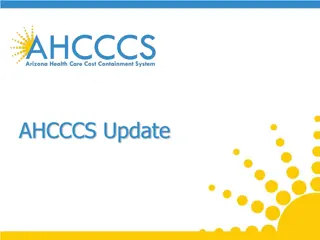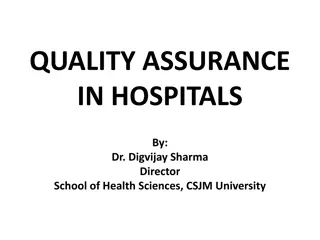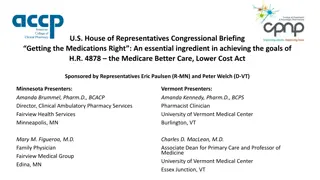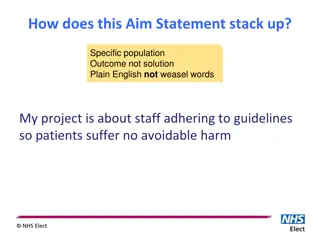Improving State Guaranteed Healthcare in Kazakhstan
The Ministry of Healthcare of the Republic of Kazakhstan is focusing on enhancing the state guaranteed benefit package to provide universal health coverage and manage chronic non-infectious diseases. The goal is to shift towards disease prevention rather than expensive hospital treatments, ensuring access to quality healthcare services and affordable drugs. Demographic trends in Kazakhstan point to increased life expectancy and a rising burden of chronic diseases, prompting the need for better funding and efficiency in healthcare services to reduce out-of-pocket expenditures and tackle the SGBP deficit.
Download Presentation

Please find below an Image/Link to download the presentation.
The content on the website is provided AS IS for your information and personal use only. It may not be sold, licensed, or shared on other websites without obtaining consent from the author. Download presentation by click this link. If you encounter any issues during the download, it is possible that the publisher has removed the file from their server.
E N D
Presentation Transcript
Ministry of Healthcare of the Republic of Kazakhstan Ministry of Healthcare of the Republic of Kazakhstan medical file Concerning measures to improve the list of the state guaranteed benefit package Astana, June 2018 Astana, June 2018 1
Global trend: to provide universal health coverage and manage chronical non- infectious diseases State of the Nation Address by the President of the Republic of Kazakhstan Nursultan Nazarbayev, January 10, 2018 Modern health care should focus more on disease prevention rather than on expensive hospital treatment. It is necessary to develop a new model of the guaranteed scope of free medical care by defining clear boundaries of state obligations. People will be able to receive services not guaranteed by the state by becoming a member of the system of compulsory social health insurance or through voluntary medical insurance as well as co-payment. Generally accepted international standard: universal heath coverage Access to quality health services; Access to safe, efficient and financially affordable drugs and vaccines, and financial risk protection 2
Demographic trends: increased live expectancy, changing age-sex composition, high impact of chronic non-infectious diseases Expected life expectancy 72,4 years (in 2016. 6,3 years increase since 2006), forecasted increase of this indicator Population increase of the most intense recipients of medical services: children (23% increase by 2025, from 5,6M to 6,9M people), elderly (41% increase by 2025, form 1,9M to 2,8M people) Chronic noninfectious diseases are the major causes of death and disability among population (cardio-vascular diseases, cancer, respiratory diseases, diabetes, etc.). 5,8M patients with chronic diseases are registered for dispensary care in Kazakhstan (2017) Major causes of life-years loss due to diseases and disabilities in Kazakhstan between 1990-2010 (Lancet, World Bank, 2011) Top 5 population mortality causes distribution in Kazakhstan 2016 (74% of total mortality cases) Other chronic noninfectious diseases EXTERNAL CAUSES OF MORTALITY AND DISEASE OCCURRENCE, 14,468, 17% Cardiovascular diseases DISEASES OF CARDIOVASCULAR SYSTEM, 33,993, 41% DIabetes 19% 4% 48% Traumas 5% TUMORS, 16,453, 20% 14% Infectious diseases and nutrition malfunctions 10% Maternity and child RESPIRATORY SYSTEM, 18,428, 22% 3
Due to insufficient funding of state guaranteed benefit package, citizens are forced to bear significant health expenditures that can lead to poverty 940,1 State guaranteed benefit package deficit dynamics and population s out-of-pocket health expenditures 608.1 887.7 729.3 679.7 Total health expenditures in Kazakhstan (3,7% of GDP) are significantly lower than in countries with same level of development (6% GDP). The share of private expenditures on health is 41% that is twice higher than maximum threshold recommended by WHO (20%) More than 30% of private expenditures are spent on procurement of self-paid health services declared within SGBP framework. 362,5 317.4 279.4 260.2 248.2 237.6 268.3 373.9 542.2 646.8 (National health accounts for 2017, preliminary report) 2013 2014 2015 2016 2017 SGBP deficit " " Out-of-pocket private expenditures SGBP expenditures RECOMMENDED HEALTH EXPENDITURES (6% OF GDP) 3,1T KZT State-paid medical care deficit (G KZT) 308,7 126,1 164,3 18,3 Medical services payed out-of pocket by population (G KZT) Medical services 236,4 58,4 146,7 11,3 19,6 Inpatient care Outpatient care Rehabilitation Dental services STATE GUARANTEED BENEFIT PACKAGE DEFICIT 362,5G KZT Drugs and medical equipment Drugs Medical equipment Other services 404,3 299,2 105,1 37,3 678 41,9 41,9 PRIVATE EXPENDITURES 678,0G KZT 11,9 362,5 STATE GUARANTEED BENEFIT PACKAGE 940,1G KZT Total 4
Consumption of primary care and clinical diagnostics Registered consumption of primary healthcare services in 2017: 47,8M visits 17,3M visits 15,9M visits 4,6M visits 7,5M visits 7,1M visits prophylactical Due to disease At home Dispensary patients Dispensary observation of 5,8M patients with chronic diseases doesn t meet quality standards: Annual visits frequency of primary care facility - 1,2 visits per patient instead of 2 visits per patient required. Demand of diagnostic services ( 96G KZT) is not factually backed up by budgeted financing. 5
Consumption of inpatient care and daycare: the main consumer of hospital care is economically inactive population (2017 .) (2017) Inpatient care consumption Population ( ) Major diseases and conditions categories , , , , - , , , , , , , , , ( - ), , , , , , , , cardiovascular, respiratory and digestive systems Children 13% Respiratory diseases, infections, perinatal pathology and traumas Psychological disorders, cardiovascular diseases, osteoarticular diseases, diseases of nervous system CAD, cerebrovascular disease, diseases of eye lens, diabetes, arthroses, Chronic obstructive lung disease and diseases of digestive system. People with disabilities 5% 46% Elderly 15% ( ) ( ) (not registered) Conditions related to pregnancy and labor, diseases of genitourinal and respiratory system Psychological disorders (psychotropic substances), cardiovascular diseases, head injuries, TB, Cerebrovascular diseases Conditions related to pregnancy and labor, diseases of 13% Unemployed (registered) Unemployed 10% Others 54% 44% Among patients who has received inpatient hospital treatment ( 2,9M treated cases): By hospitalization types 68% of all cases emergency hospitalization By social status 46% of patients are preferential social groups of population (in compliance with Law About Mandatory Social-Medical Insurance ) who receive 47% of allocated budget on inpatient care By disease types 24% (698,9k cases) chronical noninfectious diseases Approximately 20% of treated cases could be successfully treated in daycare facility Among patients received the day care ( 1,12M cases): By consumer categories 61% of population are welfare beneficiaries (in compliance with the law About MSHI ) By disease categories 42% (471,4K people) patients with chronic diseases registered for dispensary care 6
Consumption of rehabilitation and palliative care Structure of patients who did not receive necessary 2ndand 3rdstage rehabilitation (180,5K patients, 2017) After severe nervous system injury 43 Welfare beneficiaries : 53% Not registered unemployed: 13% Primary pulmonary hypertension 145 Bone-marrow injury 348 After keyhole surgeries 1 586 Rheumatic valvular heart disease 3 394 Post-surgery treatment of deformations and fractures of vertebra 4 270 Cardiomyopathy Brain injuries 4 538 12 522 Post-operation after joint replacement 15 689 Myocardial infraction 15 871 After limb bone fracture 27 552 Angina (angina pectoris) Post-surgery 44 517 50 011 Planned budget (under current tariffs) doesn t consider factual demand on rehabilitation and palliative care, covering only: 20% of rehabilitation cases (cardiology, cardiosurgery, neurology, orthopedics) 34% cases for palliative care (cancer, TB, terminal stage of organ failure, etc.) 7
Solutions: establishment of a three-level healthcare delivery system, based on staged introduction of new SGBP model Optimization of SGBP Comprehensive list of dynamically observed and socially significant diseases Exclusion of outdated methods Comprehensive list of diagnostic services NEW MODEL OF SGBP (basic services) ADDITIONAL SERVICES: paid services, voluntary health insurance, co-payment MSHI Regular updates of SGHP and MSHI (atop SGBP and new services) MSHI PACKAGE: atop SGBP and new services III STAGE I STAGE II STAGE Draft of Government resolution Draft of the law About MSHI NEW SGBP MODEL: basic health services Introduction of MSHI 8 * SGBP will associate with minimal social standard (The law of the RK About minimal social standards and their guarantees
I STAGE: Major optimization directions of SGBP Primary care Diagnostics Inpatient care 769 diagnostics and 529 surgeries and manipulations to be treated in daycare facilities Dispensary disease list was optimized from 259 to 29 diseases 959 outdated and inefficient services were excluded Increase access of population with demographically harming diseases to primary care units Decrease burden of medical workers Increase access and quality of diagnostics of demographically harming diseases Decrease inpatient care expenditures Increase access to cost-effective daycare treatment Dynamical observation does NOT include: Osteochondrosis Iron-deficit anemia Deforming osteoarthrosis Nonincarcerated hernia Hydrocephalus Alzheimer disease Nonrheumatic arthritis and others Excluded: Consultations: transplantologist, anesthesiologist, Immunologist, clinical pharmacologist, reflexologist, dietarian and others Services: Manual biochemistry, microbiology on analyzation, EIA, STD, CLIA and others Excluded: Iron-deficit anemia, conjunctiva, Chronic bronchitis, gastritis, dermatitis, arthritis and others Eye surgery, tonsillectomy, excision of varicose veins, arthroscopy, laparoscopically excision of hernia, incision and drainage of an abscess, and others 9
Healthcare services distribution of SGBP and MSHI NEW MODEL OF SGBP MSHI PACKAGE (FOR INSURED CITIZENS) Healthcare to improve quality of life of EVERY PERSON, Foundation for the future generations health Healthcare for EVERY PERSON with emergency or acute condition Control over SOCIALLY SIGNIFICANT diseases. For all citizens 1.Emergency care and air medical services 2.Primary care 3.Emergency day care and inpatient hospital treatment 4.Palliative care For people with socially major chronic diseases 1.Diagnostics 2.Outpatient drug provision 3.Planned day care and inpatient hospital treatment 4.Rehabilitation for patients with TB 1.Diagnostics Periodic screening of adult population Specialized screening of children Expensive lab and diagnostic services 2. Outpatient drug provision atop SGBP 3. Day care for diseases on top of SGBP 4. Planned inpatient care for diseases on top of SGBP 5. Rehabilitation for adults and children by following categories: cardiology. neurosurgery, traumatology, orthopedics. significant and cardiosurgery, neurology, 10




